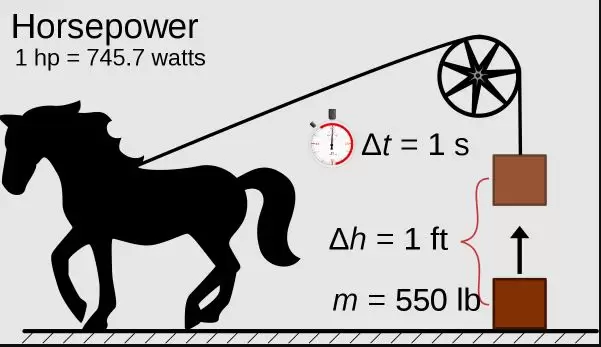Vehicle horsepower, often simply referred to as “horsepower” or “HP,” is a measure of the power output of an engine, typically used to describe the performance of cars, trucks, motorcycles, and other vehicles. It is named after James Watt, the inventor of the steam engine, who coined the term to market the power of his engines by comparing them to the work done by horses.
Horsepower is a unit of power, and in the context of vehicles, it represents the rate at which an engine can do work. Specifically, one horsepower is defined as the ability to do 550 foot-pounds of work per second or 745.7 watts. In simpler terms, it’s a measure of how quickly an engine can generate force to move a vehicle.
Origins and Significance of the Term ‘Horsepower:
The term “horsepower” was coined by James Watt, a Scottish engineer who played a significant role in the development of the steam engine during the late 18th century. Watt needed a way to market and explain the power of his steam engines to potential customers, and he wanted to relate it to something familiar and easily understandable.
At the time, horses were one of the primary sources of power for various types of work, such as pulling wagons, plowing fields, and turning mill wheels. People could easily understand and appreciate the capabilities of horses when it came to performing these tasks.
Watt conducted experiments to determine how much work a horse could do over a certain period, and he used this information to define a unit of power. He calculated that on average, a horse could turn a mill wheel with a certain force and speed, lifting a specific weight, over a specific distance. He determined that this work was equivalent to 550 foot-pounds of work per second. In other words, a horse could perform 550 foot-pounds of work in one second.
Watt used this calculation to define the term “horsepower” and applied it to his steam engines to describe their power output. By doing so, he provided a relatable and easily understandable measure of the capabilities of his engines, making it easier for people to assess their value and performance.
The concept of horsepower has since become a standard unit of power in the field of engineering, particularly in the context of engines and vehicles. It’s a testament to the enduring legacy of James Watt’s innovations in the industrial revolution and the role he played in shaping our understanding of power and energy.
Points to Understand & Compare Horse Power in Real World:
- Higher HP Equals More Power: In general, a vehicle with more horsepower will be capable of accelerating faster and achieving higher top speeds. It can also handle tasks like towing heavy loads or passing other vehicles on the highway more easily.
- Engine Size and Type: Horsepower is closely related to an engine’s size and type. Larger engines, especially those with more cylinders or forced induction (turbochargers or superchargers), tend to produce more horsepower. For example, a V8 engine typically has more horsepower than a four-cylinder engine of the same size.
- Power-to-Weight Ratio: It’s not just about how much horsepower a vehicle has; it’s also about how much weight it needs to move. A car with a high power-to-weight ratio (more horsepower and less weight) will generally feel more powerful and responsive.
- Torque Matters Too: While horsepower is crucial, torque is another important factor in a vehicle’s performance. Torque represents the engine’s rotational force, and a vehicle with good torque can feel powerful even at lower speeds.
- Transmission and Gear Ratios: The transmission plays a role in how horsepower is delivered to the wheels. Vehicles with efficient transmissions and well-matched gear ratios can make better use of their available horsepower.
- Real-World Performance: When comparing vehicles based on horsepower, it’s essential to consider how that power translates into real-world performance. Factors such as aerodynamics, tire grip, and suspension also influence how a vehicle handles and accelerates.
- Fuel Efficiency: Higher horsepower often comes at the cost of lower fuel efficiency. It’s a trade-off to consider when choosing a vehicle, as a more powerful engine may consume more fuel.
- Driving Needs: Your choice of vehicle should align with your driving needs. A high-horsepower sports car may not be practical for everyday commuting, while a fuel-efficient car with lower horsepower may be perfect for daily driving.
Different Between Horse Power & Kilowatt:
Horsepower (HP) and kilowatt (kW) are both units of power, but they are used in different parts of the world and are based on different measurement systems. Here are the key differences between them:
- Measurement System:
- Horsepower (HP): Horsepower is primarily used in the United States and some other countries that follow the imperial system of measurement. It is based on the British imperial system.
- Kilowatt (kW): Kilowatts are part of the International System of Units (SI) and are widely used worldwide, including in countries that use the metric system. The SI system is based on the metric system.
- Conversion Factor:
- 1 horsepower (HP) is approximately equal to 0.7457 kilowatts (kW).
- Conversely, 1 kilowatt (kW) is roughly equivalent to 1.341 horsepower (HP).
- Symbol:
- Horsepower (HP) is typically represented by “HP.”
- Kilowatt (kW) is represented by “kW.”
- Applications:
- Horsepower (HP) is commonly used in the automotive industry to describe the power output of engines, particularly in the United States. It’s also used in various other industries, including manufacturing and agriculture.
- Kilowatt (kW) is used in a wide range of applications globally, including in electrical engineering, manufacturing, and energy-related calculations. It’s the standard unit of power in the SI system.
- Precision:
- Kilowatts (kW) provide a more precise and universally accepted measurement of power because they are based on the SI system, which is used in scientific and engineering contexts worldwide.
- Horsepower (HP) is less precise and can vary slightly in its definition depending on the exact measurement system being used (e.g., mechanical or electrical horsepower), which can lead to some inconsistencies.

